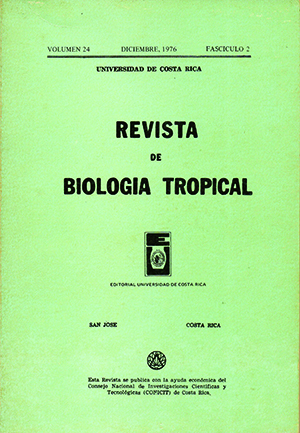Abstract
The morphology and anatomy of ovules, immature and mature seeds of 18 species of Cactaceae (pereskieae, Opuntieae and Cereae B. and R.) have been studied in an attempt to understand their development and their structure. Characteristics of the nucellus, the micropyle, the funiculus and the funicular covering (Opuntieae) in the ovule, and features of the seed coat, the embryo, the perisperm, the hilum and the hilum cup in the mature seed have been analized.
The ovular position is amphitropous in most species. The funicular covering of Opuntieae commonly called "aril or third integument" is a true funicular covering and this structure is different from that of arils. There is a relationship between the degree of thickening in the integuments and the size and form of the hilum and hilum cup. Apparently, the presence of tannins incrusted on the cell wall of seed coat cells increases the hardness of the walls and gives them the brittlenessReferences
Arber, A. 1910. The Cactaceae and the study of seedlings. New Phytol., 9: 33-337.
Archibald, E. E. A. 1939. The development of the ovule and the seed of jointed cactus (Opuntia auran tiaca Lindley). S. Afr. J. Sci., 36: 195-211.
Bhatnagar, S. B., & B. Johri 1 972. Development of angiosperm seeds, p. 79-149. In T.T. Kozlowski (ed.) Seed Biology V. 1. New York. Academic Press.
Bravo, H. 1937. Las Cactáceas de México. U.N.A.M. Imprenta Universitaria, México. Briton, N., & N. Rose 1919-1923. The Cactaceae. Carnegie Inst. Washington Publ. No. 48 (reimpreso en 1963 por Dover Publications, Inc., N. Y.). 4 Vol.
Buxbaum, F. 1950. Morphology o[ Cacti. Roots and Stems. Pasadena, Abbey Garden Press.
Buxbaum, F. 1953. Morphology of Cacti. Section II. The flower. Pasadena, Abbey Garden Press.
Buxbaum, F. 1955. Morphology of Cacti. Section III. Fruits and Seeds. Pasadena, Abbey Garden Press.
Buxbaum, F. 1958. Morphologie der Kakteen. IV. Samen, P. 79-97. In H. Krainz, et al., Die Kakteen, Lieferung 9. Stuttgart.
Cocucci, A. E. 1961. Embriología de Trianthema argentina. Kurtziana, 1: 105-122.
Comer, E. J. 1954. The durian theory extended. II. The arillate fmit and the compound leaf. Phytomorphology, 4: 152-165.
Cronquist, A. 1968. The evolution and classification of flowering plants. New York, Houghton Mifflin Co.
Engleman, E. M. 1960. Ovule and seed development in certain cacti. Amer. J.
Bot., 47: 460-467.
Eyde, R. H. 1966. Systematic anatomy of the flower and fruit of Corokia. Amer. J. Bot., 53: 833-847.
Fahn, A. 1967. Plant Anatomy. New York, Pergamon Press.
Ganong, W. F. 1898. Upon polyembryony and its morphology in Opuntia vulgaris. Bot. Caz., 25: 221-228.
Huber, J. A. 1929. Blüten und Samenentwicklung der Kakteen und ihre Bedeutung für deren systematische Stellung. Monatsschr. Deutsch. Kakteen-Ces., 1: 175-190.
Huber, J. A. 1937. Die Entwicklung der Samen bei den Kakteen. Cactaceae (Mail),: 9-12.
Kapil, R. N., & l. K. Vasil 1963. Ovule, p. 41-67. In P. Maheshwari (ed.), Recent advances in embryology al angiosperms. Delhi, Int. Soc. Plant Morphologists.
Maheshwari, P. 1950. An introduction to the embryology al angiosperms. New York, McGraw Hill Co.
Maheshwari, P. 1964. Embryology in relation to taxonomy, p. 55-97. In W. B. Turril (ed.), Vistas in Botany. New York, MacMillan.
Maheshwari, P. & R. N. Chopra. 1955. The structure and development of the ovule and seed of Opuntia dillenü Haw. Phytomorphology, 5: 112-122.
Mauritzon, J. 1934. Ein Beitrag zur Embryologie der Phytolaccaceen und Cactaceen. Bot. No tiser., 1934 III: 135.
Neuman, M. 1935. Die Entwicklung des Pollens, der Samenanlage und des Embryosackes von Pereskia amapola varo argentina. Oster. Bot. Z., 84: 1-30.
Raghavan, G. S. & V. K. Srinivasan 1940. Studies in the Indian Aizoaceae. Ann. Bot. (London), N. S. 4: 651-661.
Sass, J. E. 1958. Botanical Microtechnique. Iowa State Univ. Press, Ames.
Sharma, H. P. 1963. Studies in the order Centrospermales II. Vascular anatomy of the flower of certain species of the Molluginaceae. J. Indian Bot. Soc., 42: 19-32.
Spome, K.R. 1954. Statistics and the evolution of dicotyledons. Evolu tion, 8: 55-64.
Spurr, A. R. 1969. A low-v iscosity epoxy resin embedding medium for electron microscopy. I. Ultrastr. Res., 26: 31-43.
Tiagi, Y. D. 1954. Studies in the floral morphology of Opuntia dillenii Haw. Il. Development of the ovule and gametophytes. Bot. No tiser., 4: 343-356.
Tiagi, Y. D. 1956. Polyembryony in Mam millaria tenuis D. C. Bull. Bot. Soc. Un iv. Saugar, 8: 25-27.
Tiagi, Y. D. 1957. Studies in floral morphology. III. A contribution to the floral morphology of Mammillaria tenuis D. C. J. Univ. Saugar, 6B : 7-3 1.
Tiagi, Y. D. 1967. Contribution to the embryology of the genus Pereskia. Proc. 54th Indian Sci. Congr. 324-325.
Tiagi, Y. D. 1970. Cactaceae, p. 30-35. In Symposium o n comparative embryology of A ngiosperms. Indian Nal. Sci. Acad. New Delhi. pp. 30-35.
Van der Pijl, L. 1972. Principies of dispersal in higher plants. 2a ed. New York, Springer Verlag.
##plugins.facebook.comentarios##

This work is licensed under a Creative Commons Attribution 4.0 International License.
Copyright (c) 1976 Revista de Biología Tropical


